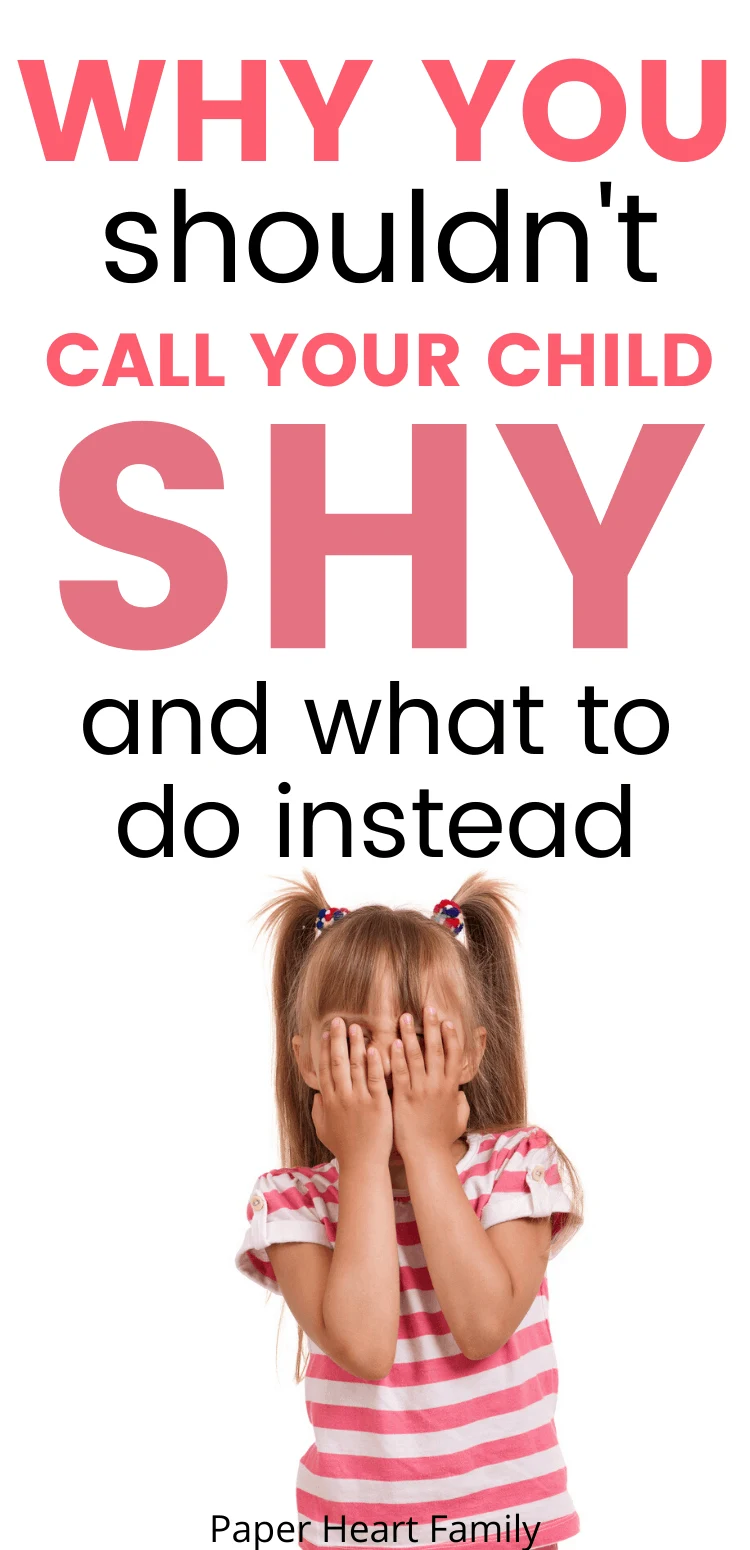Does your child cling to you in social settings? Does he often complain of an upset stomach or headache when it’s time to be around other people? You can help your shy child gain confidence.
Shyness means your child feels nervous and vulnerable in social settings. It’s different from introversion, where children need solitude to recharge. Children who are shy want to be more social–it’s just uncomfortable.
Most children feel shy at times. But some children’s shyness is so intense that it’s difficult to make friends. They end up watching life “from the sidelines” rather than joining in. They may also be (unfairly) perceived as unfriendly or disinterested.
Is it normal to be shy?
In reality, lots of kids are “slow to warm up.” And it’s healthy and natural to be shy in new situations.
A Harvard study found that nearly a third of babies are born with shy temperaments. These infants became distressed around unfamiliar objects and people, and continued to be clingy as they grew older.
In a study at New York University, shyness was associated with the fight-flight-freeze reaction. Shy people were found to have an overactive amygdala, making them want to flee social situations.
“The world is a big place when you are small; many children are naturally shy, or occasionally get caught off guard and suddenly find it hard to say ‘hello’. Shyness is a very normal characteristic of early childhood.”
-Miranda Russell, childcare expert
Shyness isn’t a bad thing–experts who study it say there’s nothing wrong with being socially reserved. In fact, from an evolutionary perspective, it’s good to have some humans who are careful and attuned to potential threats.
How parents can help a shy child gain confidence
The good news is that with a little support, shy children can learn to be more engaged and connected. It is not impossible to build a child’s self esteem. They can celebrate the positives associated with shyness (creativity, leadership skills, and empathy).
Shy children don’t need to change, but they can learn to feel more comfortable.
Consider these 9 simple ways to develop your child’s confidence, and provide the opportunities they need to get them off the sidelines:
1. Model confidence (and perseverance)
One of the best ways to teach your child to be confident is by modeling the skill. Set a positive example by being friendly to strangers, initiating conversations, and offering to help others.
“Show your child how you interact with people in everyday life: at the grocery store or with family friends and have him strive to do the same.”
-Michael Reist, In Praise of Shyness
Given that shyness is hereditary, it’s quite possible that you too experience social discomfort. Share times when you had to speak up for yourself or felt nervous around peers. Talk about how your feelings of shyness come and go–no one is confident all the time.
Share self-affirmations that help you in tricky moments. These could include:
- “I’m feeling shy right now, but I can be brave too.”
- “This feeling happens each time I drive to a party, and I always end up having fun.”
Check out my list of 110 positive affirmations for kids to help you get started.
These printable affirmation cards for kids are adorable and will help to give your child’s self esteem a boost!
Making slight adjustments to your posture and body language can also project confidence. Stand up straight, keep your chin and head up, and your feet firmly planted on the ground. Eye contact (or looking close to the other person’s eyes) also shows you are interested.
Most importantly, model a relaxed and calm attitude in your social interactions so your child can too.
Using calming techniques and emotional regulation activities for kids can also make a big difference in you child’s day.
If your child struggles with test anxiety, these affirmations for exam success are so helpful.
2. Refrain from calling them “shy”

Referring to your child as “shy” could make her feel criticized or judged. It also implies this trait is unchangeable, and part of her identity.
According to Laurie Hollman, Ph.D., calling your kid shy makes him or her feel that you disapprove of his or her personality. This can have a negative impact on your kid’s self-esteem, which can prevent them from slowly being part of a group.
Instead, acknowledge the behavior and normalize it. You might say, “You know those butterfly feelings you get when you go to a party? Lots of people feel that way.”
If others label your child as shy or quiet, reframe it positively within your child’s earshot. Use terms like “private,” “reserved” or “focused” instead. Imply that you know and accept him exactly as he is.
3. Give them time
Many kids need time to get comfortable with new people and situations. And studies show that some shy children even grow out of it eventually.
In the meantime, there are plenty of ways to help your child warm up and gain confidence around others.
Ideas include:
- Ease in with individual playdates or small group situations
- Arrive early at parties or gatherings
- Don’t put them on the spot publicly (“Tell that new joke you learned!”)
- Start small (a sleepover versus a weeklong camp)
Keep in mind that quiet children tend to take a while before they can feel comfortable to mingle. So overprotecting them is not ideal.
Help your child “stretch” rather than trying to change who they are. There’s no need to be overprotective, but it’s okay to take it slow!
4. Discuss how to initiate play
While some kids are naturally chatty, shy children struggle with initiating interactions and play. They need direct instruction on how to engage with peers.
Start by talking about “friendly behaviors” that let people know we want to interact. These simple ideas might include:
- Smiling
- Saying “hi”
- Asking, “Can I play?”
- Standing nearby and watching a game
- Saying “please” and “thank you”
Role-play social scenarios with your child (approaching someone on the playground, asking to sit next to a friend at lunch, joining a group game, or entering a classroom). Brainstorm ways they can handle each situation. You can practice with stuffed animals or dolls to keep it fun.
With some effort, your child will gain confidence and be ready to tackle the real thing!
You can also use these fun conversation starters to build your child’s confidence.
5. Provide opportunities to practice
Interactions involving a large group of peers will feel overwhelming to your child. At the same time, shy kids need exposure to social settings.
Start by initiating a conversation with your child’s peer. Consider choosing one who already shares your child’s interests (“Did you know Emma likes art too? Emma, what’s your favorite thing to draw?). Then step back and allow their interactions to develop naturally.
When it’s time to schedule their get-together, keep in mind that playdates in a familiar or controlled setting are key. Let your child choose the place and activity when possible!
On the way, prepare by talking about what will happen, and ask if she has any worries or questions. She might even choose a secret signal to let you know she’s uncomfortable. Remind her that lots of things seem scary at first, but they get easier with practice.
6. Support their interests
Exploring their interests helps shy kids gain confidence and a stronger sense of identity. It’s a great way to develop friendships too.
When your child pursues her interests, she’s naturally focused and engaged (and unself-conscious). Doing fun things lets your shy child bond with others in a pressure-free atmosphere.
“Your child’s inner confidence in their own abilities and achievements can really help them to become more comfortable interacting with others and presenting themselves in a positive way.”
–Monikah Schuschu
Encourage exploring new activities too–from unfamiliar foods at mealtime to a trip to the local museum. Point out that trying different things is part of how we learn what we like. We’ll find that some pursuits aren’t meant for us, and that’s good information too!
For a creative way to build your child’s confidence in tackling new (and challenging) things, consider journaling as a way to document their efforts! You can also choose an interests-based journal for them to record their experiences with nature, animals, reading, or anything else that captures their hearts.
7. Change the script
Shyness sometimes results from your child’s self-talk. Children who think, “They’ll all laugh at me” or “No one likes me” are more likely to be distant and uncomfortable with peers.
Start by discussing how everyone has a way of talking to themselves–one that feels good (positive), or one that can make them feel bad or sad (negative). We don’t always choose what happens to us, but we can choose how to talk to ourselves about it.
Model self-compassion for your child. Share some of your awkward or embarrassing moments, and how you got through it. Talk about the kind words you say to yourself when social interactions don’t go as planned (“I can do hard things!” or “Everyone feels awkward sometimes”).
Finally, brainstorm a list of helpful, supportive phrases your child can say to himself. These might include: “I’ve felt nervous before, and I got through it just fine!” or “I know a few of those kids–they’ve asked me to play before.”
8. Don’t push it
There’s a difference between encouraging your child to overcome their discomfort and pushing them into uncomfortable situations. These scenarios include anything unexpected or without warning.
Forcing your child to engage when he isn’t ready will likely backfire. Feelings of anxiety and discomfort will only increase if your child has little control.
Deirdre Rooney advises that you respect your child’s pacing and limits. Sure, it can be frustrating, but there’s no need to push them beyond what they can handle.
It’s hard when your child behaves so differently at home. When the bubbly and outgoing person you know seems to disappear in front of others. But reassure yourself that in time, and with the right strategies, your child will gain those skills.
Patience is key.
9. Know when to seek help
Shyness is common, and not cause for concern in most kids. But in some cases, a child’s shyness interferes with their daily (and family) life. Attending a class party, visiting family members, or even going to school, are avoided at all costs.
If your child’s shyness seems extreme, persistent or severe, he may actually be struggling with social anxiety disorder. This disorder is different from shyness due to its intensity and the impairment of functioning it creates.
Children with social anxiety disorder avoid doing things or speaking out of fear of embarrassment and avoid any activity in which they are the center of attention. Being embarrassed or looking “stupid” are their greatest fears.
This type of anxiety is not uncommon. Somewhere between 1 and 9 percent of children are thought to have it. Because it impacts the development of social skills, and may even lead to depression, it does require extra support.
Here’s the thing: People with social anxiety experience stress, fear, and humiliation every day.
Fortunately, there are many ways to help your child with extreme shyness. Books like “What to Do When You Feel Too Shy: A Kid’s Guide to Overcoming Social Anxiety” by Claire Freedland and “Shy Ninja” by Mary Nhin are full of research-based strategies to manage anxiety. Apps like The Worry Box, Positive Penguins, and Stop, Breathe and Think are also good places to start!
In many cases, a therapist can help your child learn the strategies necessary for overcoming extreme shyness.
Wrap-Up
New or unfamiliar situations make many children feel shy. And up to a third of children are born with a shy temperament.
Far from being a negative, shyness is associated with good listening skills, compassion for others, and approachability. Children can learn to see the positives of their shyness, and how to manage the more difficult aspects of this trait.
When parents teach confidence skills like modeling friendly behavior, refraining from labeling their child, and creating opportunities to practice, children can grow more comfortable in social settings.
Remember that your shy child just needs extra time and planning to feel engaged and connected. Do not avoid or protect them from social situations, even though they are difficult. And stay patient with them (and yourself) during this process. The experiences and strategies you’re providing are setting him up for a fully, happy life.
This is a guest post written by Alexandra Eidens, one of the creators of the Big Life Journal.
Related:
- Positive Affirmation



10 Questions To Ask Your Kid To Boost Their Confidence
Sunday 23rd of March 2025
[…] If you have a child who is naturally shy, check out this article on how to help shy child grow confidence. […]
80 Questions To Ask Your Son To Get To Know Him
Monday 17th of July 2023
[…] Boosting a boy’s confidence is so important, but is often overlooked. […]
30 Things To Teach A 3 Year Old (Plus How To Do It!)
Saturday 15th of July 2023
[…] out fostering confidence and questions to build self-esteem for easy ways to build your child’s self […]
365 Questions To Ask Your Daughter To Get To Know Her
Sunday 9th of April 2023
[…] Even though these questions can be completed quickly each day, many of them can provide effective ways to talk about issues your child is facing, or a chance to start a conversation about the importance of being kind or building confidence. […]
11 Things to Do With A 2 Year Old Everyday
Sunday 9th of April 2023
[…] practice, your clingy toddler can gain confidence in being away from mommy and enjoying her own […]